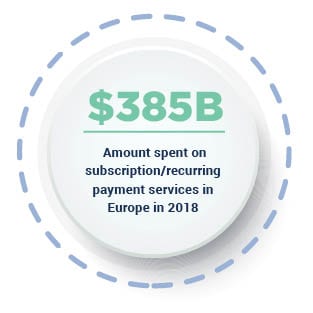 So, what happens when subscription meets rigorous payment authentication? Europe is poised to become a testing ground for this question with the implementation of Strong Customer Authentication (SCA), which is part of the European Union’s revised Payment Services Directive (PSD2) regulations. The security protocol requires that online payments undergo a combination of two of three forms of authentication: biometric, password and/or device-based.
So, what happens when subscription meets rigorous payment authentication? Europe is poised to become a testing ground for this question with the implementation of Strong Customer Authentication (SCA), which is part of the European Union’s revised Payment Services Directive (PSD2) regulations. The security protocol requires that online payments undergo a combination of two of three forms of authentication: biometric, password and/or device-based.
At first glance, it might seem that subscription enterprises could fly under the radar of the new regulations — SCA exempts recurring payments from authentication. However, there is more than meets the eye to this exemption, and it could provide subscription services a false sense of security.
In the new SCA Impact Playbook: Subscription Commerce And The SCA Opportunity, a collaboration with GoCardless, PYMNTS examines how SCA carries underappreciated risks for this dynamic segment of the eCommerce market. These can be boiled down to three Cs: conversion, churn and card-based risk.
 While SCA has the potential to reduce fraud in Europe’s eCommerce ecosystem, it could also lead to a decline in conversion, which has been a well-documented accompaniment to enhanced online security. Customers may abandon orders because of the hassle of not having payments process in a timely manner. For subscription-based businesses, this risk is especially acute because failed payment could mean not just losing out on a one-time purchase, but on customer relationships that could have lasted years. SCA-associated conversion losses could range from 10 percent to 33 percent, by some estimates. For subscription and recurring payment services in Europe, a market valued at close to $400 billion, this represents a substantial impact.
While SCA has the potential to reduce fraud in Europe’s eCommerce ecosystem, it could also lead to a decline in conversion, which has been a well-documented accompaniment to enhanced online security. Customers may abandon orders because of the hassle of not having payments process in a timely manner. For subscription-based businesses, this risk is especially acute because failed payment could mean not just losing out on a one-time purchase, but on customer relationships that could have lasted years. SCA-associated conversion losses could range from 10 percent to 33 percent, by some estimates. For subscription and recurring payment services in Europe, a market valued at close to $400 billion, this represents a substantial impact.
Having to enter payment credentials is a pain point for all online businesses, though subscription merchants may be uniquely sensitive to these frictions. After all, enjoying a seamless experience without the hassle of repeated transactions is one of the key selling points of subscriptions. PYMNTS’ past research has shown that negative registration experiences and frequently entering payment information both correspond with a greater likelihood that users will cancel their subscriptions. In other words, these are key drivers of user churn, the nemesis for any subscription enterprise.
Advertisement: Scroll to Continue
 SCA’s exemption for recurring Merchant Initiated Transactions (MITs) offers subscription businesses an important advantage. However, as long as consumers are paying with credit cards, merchants will still face conversion risk, at least on the initial purchase. For this reason, SCA presents subscription businesses with a greater opportunity to examine their payment flows, and assess whether there are payment options that are both secure and better suited for subscriptions.
SCA’s exemption for recurring Merchant Initiated Transactions (MITs) offers subscription businesses an important advantage. However, as long as consumers are paying with credit cards, merchants will still face conversion risk, at least on the initial purchase. For this reason, SCA presents subscription businesses with a greater opportunity to examine their payment flows, and assess whether there are payment options that are both secure and better suited for subscriptions.
In this regard, one possibility that has been largely overlooked by the new generation of subscription businesses is direct debit, a preferred mode of payment for utilities such an internet and cell phone services in many parts of Europe. Direct debit payments are out of the scope of SCA mostly because the fraud risk is negligible compared to credit cards.
To learn more about how subscription merchants can turn SCA into an opportunity for payment optimization and business growth, download the report.

 Subscriptions are not just for magazines anymore. The business model has grown well beyond streaming services like Netflix to encompass an ever-expanding variety of services and products, including vehicles, shaving kits and beauty supplies — to name a few. Fundamental to subscription’s appeal is that it offers consumers a regular supply of goods, while the recurring payment process remains nearly invisible.
Subscriptions are not just for magazines anymore. The business model has grown well beyond streaming services like Netflix to encompass an ever-expanding variety of services and products, including vehicles, shaving kits and beauty supplies — to name a few. Fundamental to subscription’s appeal is that it offers consumers a regular supply of goods, while the recurring payment process remains nearly invisible.





